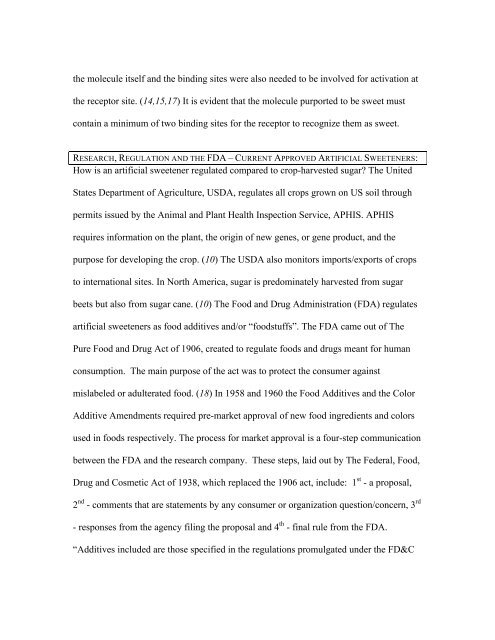ARTIFICIAL SWEETENERS: - University of Maryland
ARTIFICIAL SWEETENERS: - University of Maryland
ARTIFICIAL SWEETENERS: - University of Maryland
You also want an ePaper? Increase the reach of your titles
YUMPU automatically turns print PDFs into web optimized ePapers that Google loves.
the molecule itself and the binding sites were also needed to be involved for activation at<br />
the receptor site. (14,15,17) It is evident that the molecule purported to be sweet must<br />
contain a minimum <strong>of</strong> two binding sites for the receptor to recognize them as sweet.<br />
RESEARCH, REGULATION AND THE FDA – CURRENT APPROVED <strong>ARTIFICIAL</strong> <strong>SWEETENERS</strong>:<br />
How is an artificial sweetener regulated compared to crop-harvested sugar? The United<br />
States Department <strong>of</strong> Agriculture, USDA, regulates all crops grown on US soil through<br />
permits issued by the Animal and Plant Health Inspection Service, APHIS. APHIS<br />
requires information on the plant, the origin <strong>of</strong> new genes, or gene product, and the<br />
purpose for developing the crop. (10) The USDA also monitors imports/exports <strong>of</strong> crops<br />
to international sites. In North America, sugar is predominately harvested from sugar<br />
beets but also from sugar cane. (10) The Food and Drug Administration (FDA) regulates<br />
artificial sweeteners as food additives and/or “foodstuffs”. The FDA came out <strong>of</strong> The<br />
Pure Food and Drug Act <strong>of</strong> 1906, created to regulate foods and drugs meant for human<br />
consumption. The main purpose <strong>of</strong> the act was to protect the consumer against<br />
mislabeled or adulterated food. (18) In 1958 and 1960 the Food Additives and the Color<br />
Additive Amendments required pre-market approval <strong>of</strong> new food ingredients and colors<br />
used in foods respectively. The process for market approval is a four-step communication<br />
between the FDA and the research company. These steps, laid out by The Federal, Food,<br />
Drug and Cosmetic Act <strong>of</strong> 1938, which replaced the 1906 act, include: 1 st - a proposal,<br />
2 nd - comments that are statements by any consumer or organization question/concern, 3 rd<br />
- responses from the agency filing the proposal and 4 th - final rule from the FDA.<br />
“Additives included are those specified in the regulations promulgated under the FD&C




